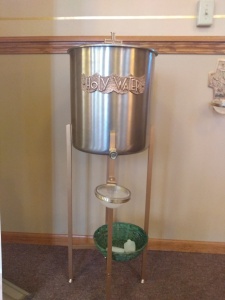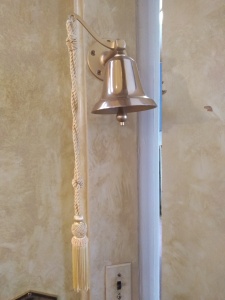 A Holy Water font stands next to the side entrance to the left as you are looking at the altar. It is a stainless-steel container that holds water that has been blessed by a priest. To bless the water, all the priest has to do is make the sign of the cross over the water. I use the old rite of blessing the water, which also includes the blessing of salt. The blessing states, “let no breath of contagion hover there…By the sprinkling of this water may everything opposed to the safety and peace of the occupants of these homes be banished…” So the prayers over this water are for the health of anybody who may be blessed by it, is sprinkled with it, or even ingests it. It is not for a person to drink like any other water. One may drink it when under great temptations, deep anxiety, or in need of spiritual defense. Only a sip is needed. You can bless yourself or others with it. It is encouraged for the family to bless each other at night before you go to bed. Before you go into places with high stress, bless yourself with holy water. You can sprinkle it in your home, work or any place. It is a very powerful tool to have at hand in your daily struggles. Carry it in your purse, have it in your car, and it is Catholic custom to have a holy water font in every room of the house.
A Holy Water font stands next to the side entrance to the left as you are looking at the altar. It is a stainless-steel container that holds water that has been blessed by a priest. To bless the water, all the priest has to do is make the sign of the cross over the water. I use the old rite of blessing the water, which also includes the blessing of salt. The blessing states, “let no breath of contagion hover there…By the sprinkling of this water may everything opposed to the safety and peace of the occupants of these homes be banished…” So the prayers over this water are for the health of anybody who may be blessed by it, is sprinkled with it, or even ingests it. It is not for a person to drink like any other water. One may drink it when under great temptations, deep anxiety, or in need of spiritual defense. Only a sip is needed. You can bless yourself or others with it. It is encouraged for the family to bless each other at night before you go to bed. Before you go into places with high stress, bless yourself with holy water. You can sprinkle it in your home, work or any place. It is a very powerful tool to have at hand in your daily struggles. Carry it in your purse, have it in your car, and it is Catholic custom to have a holy water font in every room of the house.
But where did this custom come from and are there biblical roots? Yes. It is accredited to St Augustine to say that in Jesus’ baptism, He made the water holy so that when we are baptized, we can be made holy by the water. But all this was pre-figured in the Old Testament with the waters of the great flood in Noah’s day. God cleansed the earth and made a “new beginning of goodness” (CCC#. 1219). The crossing of the Red Sea is also a pre-figurement of Baptism (CCC#1221). God’s people crossed the flowing waters of the Red Sea as He led them through the desert to the promised land. God was planning the use of Baptism and water for the redemption of humanity by the power of His cross. So the water does and should remind us of our baptism, but it has more power than just reminding us of baptism. God uses real people and real things to bring us His grace. It is very powerful.
We have two bells in the church and a set of four in the bell tower. Bells call us. Some may remember their mom ringing a bell to call their children home for dinner time. Now we have cell phones to do that. Even then, many have their phones set to ring. Church bells called any Christian within earshot to stop and pray to thank God for the benefits He had given them. Many churches today have what they call the Angelus bells. This is when the church bells ring at specific times of the day to remind people to pray the prayer of the Angelus for those who wish to. They are rung at 9am, 12noon, 3pm and 6pm. Not all churches do this, and some churches do not ring the Angelus bells at all those intervals. When these bells would ring, Catholics would stop what they were doing that very moment, and would kneel and pray the Angelus prayers. Then they would go about their business after.
There are two other bells in the church. One bell is the bell that rings when the priest comes in to offer Mass, and the other is  when the Host becomes Jesus at the consecration. At weekday Masses, the priest comes in ringing the bell to let everybody know Mass is actually starting. Sometimes the priest is getting everything set up and is walking in and out of the Sanctuary of the Church, and the people are never quite sure when Mass is actually starting. That bell can avoid such confusion. The other bell is what the altar server rings at the consecration. It lets people know that something very important is happening. There are three times that they ever ring the bell. The first time is when the priest is starting to pray over the gifts (bread and wine) as a whole, then again when the priest raises the host that has just become the body of Jesus, and finally, when he raises the wine in the chalice that has just become the blood of Jesus. In a certain way, Jesus is calling us to a very special meal and sacrifice.
when the Host becomes Jesus at the consecration. At weekday Masses, the priest comes in ringing the bell to let everybody know Mass is actually starting. Sometimes the priest is getting everything set up and is walking in and out of the Sanctuary of the Church, and the people are never quite sure when Mass is actually starting. That bell can avoid such confusion. The other bell is what the altar server rings at the consecration. It lets people know that something very important is happening. There are three times that they ever ring the bell. The first time is when the priest is starting to pray over the gifts (bread and wine) as a whole, then again when the priest raises the host that has just become the body of Jesus, and finally, when he raises the wine in the chalice that has just become the blood of Jesus. In a certain way, Jesus is calling us to a very special meal and sacrifice.
